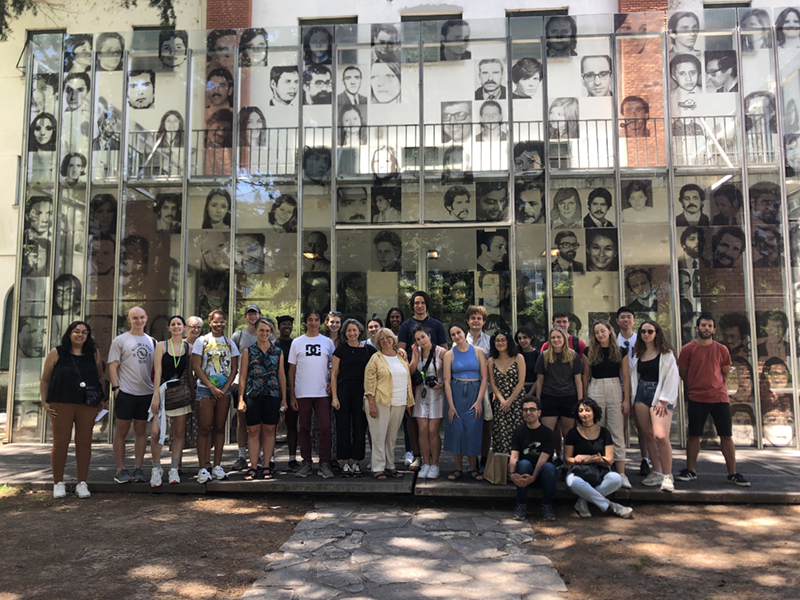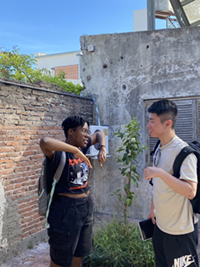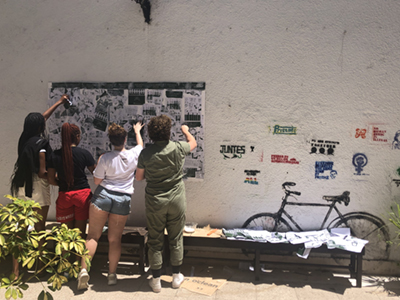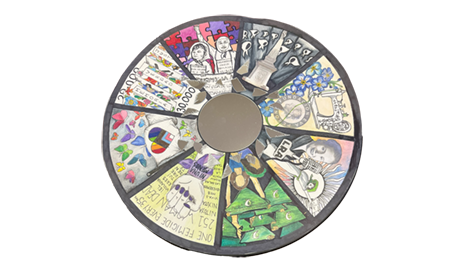A short program studying human rights in Argentina makes a lasting and tangible impression

By Kate Hoving
Silvia Tandeciarz, Vice-Dean for Social Sciences & Interdisciplinary Studies and Chancellor Professor of Hispanic Studies, has been taking William & Mary students to La Plata, Argentina, on summer and semester study abroad and internship programs for more than 20 years. The program focuses on human rights, and to Tandeciarz, a native Argentinian, the programs are very much relevant to current and future generations. “Argentina’s last dictatorship and the transitional justice process that followed was instrumental not only in shaping Argentina’s contemporary socio-political landscape but also in signaling to the world the kind of accountability that could be possible in post-conflict settings. Argentina’s “Dirty War,” its 30,0000 disappeared, and its stolen children (said to have inspired Margaret Atwood’s The Handmaid’s Tale) are well known across the world, and so are the human rights movements that followed.”
The longevity, quality and successful outcomes of the programs she credits to the longstanding partnership William & Mary has with the Comisión Provincial por la Memoria (CPM), an NGO that focuses on issues of human rights.
“The Memory Commission (CPM) was founded to promote democracy and human rights in the wake of Argentina’s last, brutal dictatorship (1976-1983), and its president is 1980 Nobel Peace Laureate Adolfo Perez Esquivel,” Tandeciarz explains. “In developing our study abroad program, we intentionally built it around interdisciplinary approaches to human rights. Because of the CPM’s internationally recognized profile, their affiliation with the National University of La Plata, and their deep and long-standing engagement with human rights work in the field (vis-a-vis both the past and the present), our students are given exceptional access to sites, organizations, scholars, activists and human rights professionals and gain first-hand experience working alongside practitioners in a focused, issues-driven program. It’s really very special and transformative for our students.”
The strong connection with CPM has enabled the flexibility to make variations and enhancements of the programs over the years, and the most recent adjustment has been to create a two-week winter program, which began in January 2022.
Adapting the La Plata experience for winter term
William & Mary’s longer winter term has enabled the Reves Center to design and offer study abroad programs that are shorter in length and less costly than summer or semester programs. Winter programs appeal to students who might not otherwise consider study abroad, such as those in STEM majors or with low foreign language proficiency.
programs that are shorter in length and less costly than summer or semester programs. Winter programs appeal to students who might not otherwise consider study abroad, such as those in STEM majors or with low foreign language proficiency.
But these same aspects—shorter duration and varied student backgrounds—require some substantial adjustments to curriculum, living arrangements and expectations.
“I’d say that if the semester program is the equivalent of a feature length-film, the winter program is a song or a poem,” Tandeciarz says. “Most of the key components are there; but they are put together in a way that helps students make sense of a very intense experience with the guidance and help of the faculty director. When students go to Argentina for the semester program, they are immersing themselves in a foreign language and culture, living with host families, and making decisions based on their own interests, how and where to invest their time and attention: they choose which courses to pursue at the National University, how to structure their free time, what internship area they want to dive into. The semester program requires strong (intermediate) Spanish language skills because the students are fully immersed in Spanish language instruction and engage in internships related to human rights.”
In the winter program students are housed together in a hotel. They have fewer opportunities to develop and deepen their own relationships with locals, simply by virtue of time limits and the intensity of the program schedule; and they have less free time, generally. Making the experience equally meaningful just requires a little more ingenuity.
Take the level of language ability, for instance. “In conversation with the CPM, we brainstormed ways to make the kind of experience offered in the semester program available to more students,” Tandeciarz recounts. “The key was to be able to offer simultaneous interpretation for all activities. The CPM was able to identify an amazing team of interpreters and purchased the necessary equipment to make this short, intensive program possible. Faculty leadership means that all debriefs, reflections, and impromptu lectures can happen in English.”
Accommodating less fluency in country does not take away from required preparation. Students engage in pre-departure sessions to acquire a basic understanding of Argentine culture and the recent Argentine history that shapes today’s human rights landscape.
engage in pre-departure sessions to acquire a basic understanding of Argentine culture and the recent Argentine history that shapes today’s human rights landscape.
“They arrive in Argentina and hit the ground running: they learn more about the work of the CPM, visit sites of memory, engage in hands-on workshops, and meet with individuals and groups to talk about past and ongoing abuses as well as strategies of resistance.”
And despite the shorter time frame, students meet and talk with a wide range of Argentinians. “They speak with survivors of the dictatorship, Mothers and Grandmothers of Plaza de Mayo seeking their missing children and grandchildren, veterans of the Malvinas/Falklands war, current victims of state violence, and a very broad spectrum of activist groups organizing for rights.”
On the ground for the second winter program
In January 2023, Tandeciarz led the second cohort of the new winter program, and Teresa Longo joined her as co-director. Longo is Associate Provost for International Affairs, Executive Director of the Reves Center as well as a professor of Hispanic Studies. Although she has been involved in behind-the-scenes administrative work for the program in her various roles over the years, it was Longo’s first time as co-director of the program and her first time in Argentina.
Twenty William & Mary students participated, representing a wide variety of majors and ages: students preparing to graduate, writing honor’s theses, and studying for the LSAT, and students just beginning and defining their academic journeys. A few were international students. To Longo, their perspective was crucial. “When we were in group discussions, we talked about Argentina but also about the U.S. and the countries the students came from, so the conversations had a truly global dimension.”
students preparing to graduate, writing honor’s theses, and studying for the LSAT, and students just beginning and defining their academic journeys. A few were international students. To Longo, their perspective was crucial. “When we were in group discussions, we talked about Argentina but also about the U.S. and the countries the students came from, so the conversations had a truly global dimension.”
She describes the entire experience as “very hands-on” learning. “People with expertise talked and students listened before any conversations. They heard from faculty with Ph.D.’s and from people who had been detained during dictatorships--it was lived and scholarly experience combined.” And another benefit of a long-term collaboration: “We wouldn’t have this kind of access and experiences without this partnership with CPM.”
 Longo has managed study abroad programs before, so she had a sense of what was in store for the students as well as the directors. “I expected the experience to be intense because it’s on the ground human rights work. I expected there to be hard work, and hands-on learning, because that’s the nature of intense learning in study abroad. I expected the students to be challenged and transformed,” Longo explains.
Longo has managed study abroad programs before, so she had a sense of what was in store for the students as well as the directors. “I expected the experience to be intense because it’s on the ground human rights work. I expected there to be hard work, and hands-on learning, because that’s the nature of intense learning in study abroad. I expected the students to be challenged and transformed,” Longo explains.
What she hadn’t expected was some of the content and the quality of the discussions.
“I was surprised by the very first formal session we had at the CPM on race and racism. Given the fundamentally different way the professionals at CPM addressed the issues--class figures as a central component in every discussion of racism in Argentina--I was surprised by how well the students responded to that narrative.,” Longo says.
Longo and Tandeciarz found the students were not only open minded about examining issues such as racism with this different approach, but they also didn’t shy away from the difficulty and intensity of the discussions. “One day at about 7pm, we let the students know we’d be in the hotel lobby in case anyone wanted to do a debrief, and almost all of them came and were there until midnight. Everyone was totally into it,” Longo recalls.
racism with this different approach, but they also didn’t shy away from the difficulty and intensity of the discussions. “One day at about 7pm, we let the students know we’d be in the hotel lobby in case anyone wanted to do a debrief, and almost all of them came and were there until midnight. Everyone was totally into it,” Longo recalls.
The role of arts and creativity
An added feature of the 2023 winter program was to incorporate the arts in a final student project rather than a term paper. Whether visiting museums, seeing street murals or hearing prisoners recite their poetry, Longo says, “Our guiding question throughout our encounters was, ‘What is the relationship between human rights and the arts?’”
For the culminating work, Longo and Tandeciarz were hoping to inspire more than pictures of places they had visited or people they had met.
“We made it clear that it was important to look at art everywhere as a creative solution to geopolitical problems,” Longo explains. “To find answers for big problems like how to promote human rights, you have to be a creative thinker. We didn’t expect them to become artists, but we made them do a creative project in order to bring out that skill, that way of thinking.”
problems,” Longo explains. “To find answers for big problems like how to promote human rights, you have to be a creative thinker. We didn’t expect them to become artists, but we made them do a creative project in order to bring out that skill, that way of thinking.”
The assignment was designed to give students plenty of latitude. Students were asked to demonstrate what they learned in Argentina about human rights and the work of art in the world and to express what they learned through a creative piece.
The resulting projects were as unique as the students and were displayed at a reception in the Reves Center in the spring.
Students exceeded all expectations, with projects running the gamut from creating wearable fashion and three-dimensional building blocks to poetry and paintings. Each work was unique with regard to medium, focus, size and the story it told.
 Tandeciarz remembers how moved she was when she saw the students’ final projects all together for the first time at the Reves reception. The depth of engagement and the care they put into their pieces were evident, as was the inspiration they took from all the forms of artistic expression addressed to human rights that they encountered in Argentina. But even more important was their ability, through creative work, to bring their insights home. To communicate what they learned from the experience, they had had to process it, reflect on it from their own place in the world, and turn it into something tangible and new, something to share with others that also expressed their own journey. The results were inspiring and affirming—this is what it’s all about, why we do what we do.
Tandeciarz remembers how moved she was when she saw the students’ final projects all together for the first time at the Reves reception. The depth of engagement and the care they put into their pieces were evident, as was the inspiration they took from all the forms of artistic expression addressed to human rights that they encountered in Argentina. But even more important was their ability, through creative work, to bring their insights home. To communicate what they learned from the experience, they had had to process it, reflect on it from their own place in the world, and turn it into something tangible and new, something to share with others that also expressed their own journey. The results were inspiring and affirming—this is what it’s all about, why we do what we do.
Human rights in conversation and in the mirror
Longo sees the experience as an opportunity to learn not just about the human rights abuses, but about a country’s responses to the abuses.
“You might think going to study a country that has lived under dictatorship and come out of it, that the constant conversation would be on abuses, but actually the conversation is on the responses to transform the situation. That’s what’s happening in La Plata.” And she continues, not only is the conversation happening, but it’s also not hidden. “This conversation is very public. Street signs say, ‘A human rights violation happened in this building.’ You can’t not see it.”
And you can’t look away from yourself.
Longo was struck by the number of mirrors she saw. “CPM and the museums have a lot of mirrors. The invitation is to see yourself in this history. No one is outside of it.”
Video interviews with four of the students and their art projects are available online at the W&M Studio for Teaching & Learning (STLI) Youtube channel.
 Skip to main content
Skip to main content
